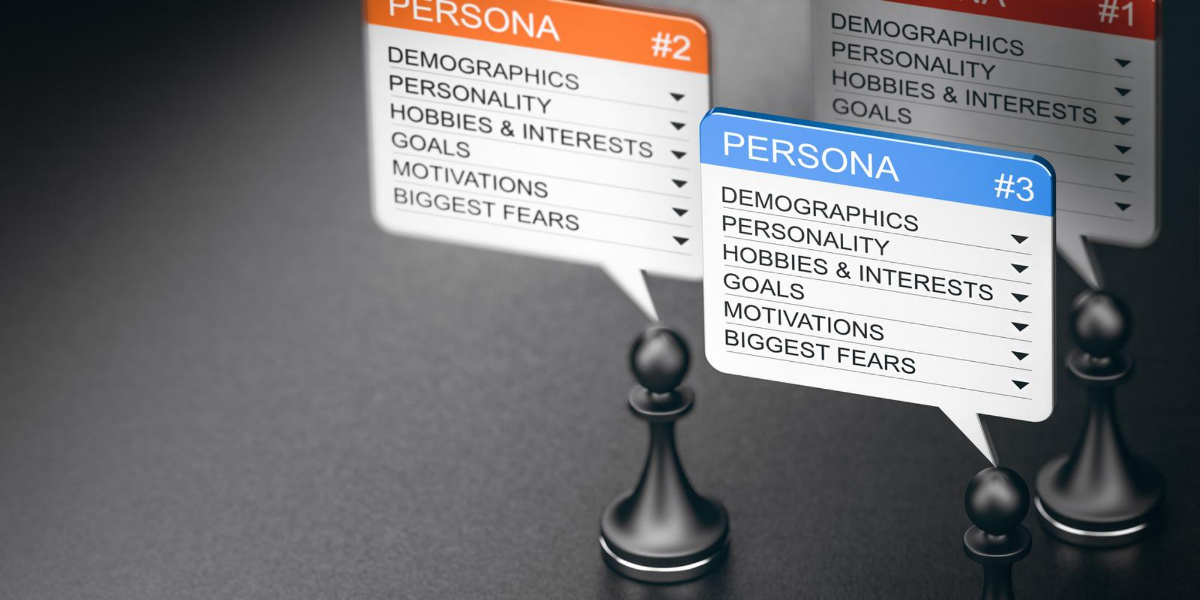
Have you ever felt like you’re talking to a wall when creating content for your customers? Creating content that resonates with your target audience can feel like an uphill battle, but understanding customer personas is the key to success. It’s like unlocking a secret code to crack the puzzle of connecting with the right people.
Customer personas are profiles of potential customers based on real data and research about their behaviours, beliefs and desires.
By constructing these archetypes, companies can gain valuable insight into who they should be targeting and how to reach them effectively.
No matter what industry you’re in, understanding customer personas is essential for crafting successful marketing strategies that will engage and entice your desired audience. In this article, we’ll explore what exactly customer personas are and how they can help you create better content.
Definition Of A Customer Persona
Customer personas are essential for product development and understanding your target audience. They provide a detailed look at your ideal customer and help you better understand the demographics of the people who buy your products.
A buyer persona is an imaginary representation of your real customers, created with demographic details and information about their preferences, motivations and goals.
By creating customer personas, businesses can create a more personalized approach to marketing and develop better strategies to target their ideal customers.
This allows them to focus on the people who are most likely to purchase their products or services, instead of wasting time and resources on those who are unlikely to be interested in what they offer.
Using customer personas enables companies to tailor their messaging for specific types of customers, ensuring that they’re speaking directly to the needs of each individual.
By taking into account the different desires, motivations and challenges faced by different segments of their target audience, companies can create a more effective marketing strategy that resonates with each segment.
This approach puts customers at the center of the product development process and helps ensure that all products or services are designed around meeting their needs.
Companies can also use customer personas as a guide for improving existing products or services and creating new ones that meet the needs of their target market.

Advantages of Using a Customer Persona
Utilizing customer personas is an effective method for businesses to gain a deeper understanding of their target customers. Marketers use user personas to create campaigns that speak directly to real people, instead of a generic audience.
A customer persona is a depiction of your target customer, derived from market analysis and data from existing customers.
This helps you get an understanding of different types of customers, their motivations, goals and behaviours – giving you the information needed to create effective marketing personas.
Once you have identified certain customer types, you can then tailor content and experiences for them along their individual customer journey.
You can also create buyer persona templates for each type of customer which can be used by all departments in the organisation.
Overall, having well-defined customer personas gives your team a clear view on who they are creating products, services or content for – allowing them to craft experiences that are more likely to result in a successful outcome.
Being able to identify with specific clients allows you to build relationships with them that are tailored just for them – giving them exactly what they need when they need it most.
Knowing this information will help marketers create marketing plans that will be more effective in reaching the right people at the right time with the right message.
With this knowledge at hand, businesses can now move forward with creating an effective customer persona – all while ensuring they meet their desired objectives!
Creating A Customer Persona
Creating a customer persona is an essential step in understanding your potential customers. By developing customer profiles, sales teams can gain valuable insight into the buying decisions of their target audience. This helps them tailor their marketing campaigns to the needs and experiences of their customers.
The process of creating a customer persona starts with research and data analysis. There are a few ways to go about this, the traditional method or by using an AI research tool.
In the traditional method, you would consider market research, surveys, and interviews to uncover key insights about their target market.
With an AI tool you can have a lot of this done for you based on information freely available online. This is how I create personas for the work I do, and I’ll demonstrate how effective it is shortly.
Through either data collection process, you can create meaningful customer personas that accurately reflect the preferences of potential customers.
After creating customer personas, it’s important for companies to continually review them for accuracy. Market trends can evolve quickly, so businesses must stay abreast of changes in order to create effective marketing campaigns that meet the needs of their target audience.
With detailed customer profiles in hand, businesses can better understand the motivations and behaviors of different types of consumers—enabling them to craft more effective strategies and deliver better results.
By taking the time to create accurate customer personas, companies can ensure they are delivering value through tailored messaging that resonates with their target audience.
This allows them to build better relationships with existing customers while also increasing their chances of attracting new ones—making it easier than ever before for businesses to reach their full potential.
Using AI to Create a Customer Persona
I recently worked with an interior designer who wanted to pivot her business away from commercial contracts to domestic clients.
Step 2 of my Growth Jetpack plan is to create an ideal customer persona and this was something she really struggled with. She does have access to research or marketing teams, and was concerned she’d be unable to figure out client pain points.
CrawlQ to the rescue! By entering some basic seed information the platform was able to build an ideal customer profile from data gathered from Google, Reddit and Quora, automatically surfacing some amazing insights.
Customer Persona Example
Here is a small example of just some of the information we gained from the AI created persona.

Helen is my ideal prospect for interior design. She is a 37-year-old mother of three kids who is struggling to maintain her family home.
She desires to move into a new house and wants it to look great and comfortable for her family.
Helen believes that good interior decor can make life more enjoyable and stress-free, so she is looking for a professional interior designer who can help her achieve this goal.
3 strong personal traits of my Ideal Prospect
1. Helen is very creative and has a great eye for design.
2. She is very organized and efficient, always making sure that her home is clean and functional.
3. She is a very happy person, who loves spending time with her family and enjoys having a comfortable home to come back to at the end of the day.
3 most crucial interests or hobbies of my Ideal Prospect
1. Helen is interested in interior design for happiness, as she believes that good design can make life more enjoyable and stress-free.
2. She is also a busy mother of three kids and desires to move into a new house that looks great and comfortable for her family.
3. Lastly, she wants to be able to work with a professional interior designer who understands her needs and wants.
3 niche demographic factors
1. Female homeowners who are interested in interior design to improve their mood and wellbeing.
2. Homeowners who want to maximize the value of their home through design.
3. Homeowners who are looking for creative solutions to make their home more comfortable and organized.
What are the websites my ideal persona visits?
Some of the websites my ideal persona might visit include:- Home decorating and design websites such as Houzz, Pinterest, or The Spruce- Interior design magazines such as Architectural Digest or Elle Decor- Furniture stores such as IKEA, West Elm, or Crate and Barrel- Online marketplaces like Amazon or Etsy for home decor
Identify 5 likely purchase intent touch points to buying decisions
1. Word of mouth – Interior design is often a very personal service, so recommendations from friends and family are likely to be an important factor in deciding whether or not to hire a home stylist.
2. Online research – Homeowners will likely do some online research into different interior designers before making a decision. This may include reading reviews, checking out portfolios, and comparing prices.
3. Meeting with designers – Some homeowners will want to meet with several designers before making a decision. This gives them a chance to get a sense of the designer’s style and ask any questions they may have.
4. Signing a contract – Once homeowners have decided on a designer, they will usually sign a contract agreeing to work with them. This outlines the terms of the project and sets expectations for both parties.
5. Paying for services – Finally, once the project is completed, homeowners will pay their designer for their services.
Keep in mind this is a tiny sample of the insights gained. You’re able to ask it any question you want to find out more about the persona, the above are just 4 examples of the information my client found very helpful.
Manually Creating a Customer Persona
Using AI is a fantastic and affordable way to generate amazing insights. For those who would rather use traditional methods, let’s look at how we can identify our target audience and learn more about who they are as individuals without the use of this amazing platform.
Identifying Your Target Audience
To identify your target audience, think about the types of customers who are likely to be interested in your product or service.
Just like a detective looking for clues, market teams must uncover customer insights from individual customer behaviour and preferences.
A primary persona is an amalgamation of those customer insights that provides you with a snapshot of all your prospective customers.
As a business operator, understanding your target audience is vital for crafting the right user experience.
It’s like having a crystal ball – predicting which features and elements will resonate with users before they even interact with it.
Once identified, knowing this information can help you create an engaging brand narrative that resonates with potential customers.
For example, if you know who your ideal customer is – their age, interests and values – you can craft content that speaks directly to them.
This way, when prospective customers come across your content they feel seen and heard. Crafting messages tailored to specific segments of your audience will boost engagement and establish stronger connections between you and them.
Collecting Data To Build A Customer Persona
Crafting a customer persona can be like piecing together a puzzle! You have to collect the individual pieces from different sources, and then assemble them into one cohesive image of your target customer.
For an effective single customer persona, you need to understand who your typical customers are and draw insights from real user data.
To build a powerful buyer profile, it’s important to focus on both product features as well as the purchase decision process.
Data-driven research should be conducted to find out what motivates the ideal buyer for your product or service and why they would choose you over the competition.
This will help you understand their needs, wants and expectations – all which are essential in creating an accurate customer profile.
Once you have collected this information, it’s time to start utilizing demographics in your customer persona.
TIP: Look at patterns across age groups, gender and location to gain further insights into who your target audience is and how they interact with your brand or product.
Utilizing Demographics In Your Customer Persona
Believe it or not, utilizing demographics to craft a customer persona can be surprisingly difficult! After all, customer personas are real people with unique interests and goals.
Thankfully, there are actionable steps you can take to create an effective customer persona marketing strategy. Here’s what you need to consider when building a customer persona:
- Income Level: What is the average income level for your target customers? Knowing their typical income can help you determine the types of products or services they’ll be most interested in.
- Level of Education: Do your actual customers have high school diplomas, college degrees, or advanced degrees? Depending on their educational background, they may respond differently to various messaging strategies.
- Age Range: Are your customer personas in their 20s, 30s, 40s, 50s+? Their age range will also affect how you communicate with them and which topics are relevant to them.
By understanding your customer’s income level, level of education and age range, you can create more targeted and actionable customer personas that accurately reflect the needs of your actual customers.
With this information in hand, you can start developing a detailed profile that outlines your target audience’s lifestyle habits, values and purchasing preferences.
In other words, knowing who your customers are will help you better understand what they need from you—so don’t forget to take these demographics into account when crafting a powerful customer persona profile!
Developing A Customer Persona Profile
Developing a customer persona profile demands dedication and direction. Delving into the details of your actual customer base and understanding their buying journey requires rigorous research.
Reaching out to your design team, utilizing persona templates, and creating a persona based marketing strategy are all essential elements of creating an effective customer persona profile.
To get started on this dynamic process, here are four crucial components:
- Gather actual customer quotes and feedback from your current customers about their experiences with your product or service.
- Research trends in the industry to understand what potential customers may be looking for.
- Use surveys and interviews to gain deeper insights into what features or characteristics they would like to see in a product or service.
- Analyze the data collected from all of these sources to create an accurate representation of who you are trying to target with your product or service.
Customer personas can be incredibly powerful tools in helping you personalize and tailor your products or services to meet the needs of the people you’re targeting.
Crafting a comprehensive, well-rounded customer persona is key for setting up successful marketing campaigns that will resonate with your audience – providing them with the freedom they crave.
Seamlessly transitioning into analyzing and refining your customer persona will help ensure that you have an impactful presence in the market!
Analyzing and Refining Your Customer Persona
Analyzing and refining your customer persona requires a single customer segment to be broken down into individual users.
Product managers must deeply understand the behavior patterns of their target audience in order to build a realistic character. This fictional character should accurately portray the needs, desires, and motivations of real customers.
To do this, product managers need to dive deep into market research and profile data to create an accurate portrait of their target customer.
They should focus on developing a comprehensive list of demographic and psychographic attributes so they have a full picture of who they are trying to reach.
This includes understanding their pain points, what drives them, and what solutions they’re looking for.
By creating a detailed persona, product managers can gain valuable insight into the user’s journey and create tailored experiences that meet their needs.
It helps them better relate to their target audience on an emotional level and craft compelling messaging that resonates with them.
With this understanding in hand, they can build products that address the needs of their customers more effectively.
Knowing exactly who you’re targeting is essential in creating successful products and services that make an impact in the marketplace.
It’s by taking the time to analyze and refine your customer persona that you can truly unlock the potential of your business growth.
Understanding Pain Points Of Your Target Audience
Ah the joys of understanding the pain points of your target audience. Who knew customer personas could be so fun? It’s like a game of ‘Pin the Tail on the Donkey’ except you’re trying to figure out what makes your clients tick!
For marketing teams, having a deeper understanding of their customers is key to success. Using powerful tools such as behavioral patterns and negative personas, they can create an incredibly realistic picture of who their ideal customer is.
It can be difficult to understand your target audience if you don’t have access to the right resources. However, with a little bit of effort, you can gain a better insight into who they are and how best to reach them.
By creating detailed audience personas and analyzing how loyal customers interact with your products or services, you can gain invaluable insights that will help you craft messages that resonate with them.
Creating customer personas isn’t just about making sure your marketing campaigns hit the mark – it’s also about building relationships with your customers and engaging with them on a deeper level.
Through understanding their needs and wants, you can create powerful experiences for them that will keep them coming back again and again.
With this knowledge in hand, it’s time to turn our attention to crafting the perfect message for our target audience.
Crafting The Perfect Message For Your Target Audience
Crafting the perfect message for your target audience is essential to ensuring that your product or service resonates with the right people. In order to craft an effective message, you must first understand who your target audience is and what they need.
Social networks, user behavior, buyer persona documents, and actual buyer interviews are all useful tools when trying to gain insight into your audience’s characteristics.
By creating a buyer persona document that outlines archetypal representations of potential customers, you can gain an understanding of their wants and needs.
This document can also be used to identify areas where your product or service could aid in development.
Knowing how people behave online, such as their browsing habits and how often they engage with content on social networks, can help you determine which messages will have the most impact.
Actual buyer interviews are another great way to gain insight into what drives people’s buying decisions and preferences.
Through direct conversations with potential customers, you can uncover valuable information about their motivations and needs that will help you create specific messaging tailored for them.
By using these techniques to understand your customer base, you can craft the perfect message for them that speaks directly to their needs and motivates them to take action.
With this knowledge in hand, we’re well equipped to know our customer’s needs and preferences so we can craft effective messaging that resonates with them.
Knowing Your Customer’s Needs and Preferences
Capturing your audience’s attention is an art form, requiring you to build a bridge between them and your message.
To achieve this, you must understand their needs and preferences – knowing who they are and what they want from your product or service. This is where crafting the perfect customer persona comes in.
A customer persona is a representation of your ideal customer based on market research and real data about your existing customers.
It’s a key element of the design process as it helps create an understanding of the types of people engaging with your brand and how to best meet their expectations.
Adele Revella, author of “Buyer Personas”, defines it as “a semi-fictional representation of your ideal customer based on real data about your existing customers”.
Building an effective customer persona requires a step-by-step approach that includes usability testing, surveys, interviews and more.
The following list outlines some key elements to consider when creating personas:
- Demographics including age range, gender identity, marital status etc.
- Goals & challenges associated with using/purchasing the product or service
- How & where customers discover information about the product/service
- Behavioural patterns such as buying habits & purchase frequency
When done correctly, customer personas provide invaluable insights into the mindset of potential buyers which can be leveraged in developing marketing strategies for maximum impact.
Leveraging Your Customer Persona In Your Marketing Strategy
Once you have identified your customer’s needs and preferences, it’s time to leverage them in your marketing strategy.
A customer persona is a semi-fictional representation of your ideal customer. It takes into account their personal characteristics, interests, and goals, allowing you to target your market audience more effectively.
I previously mentioned the CrawlQ tool I use, it isn’t just for research, it can also be used for content development. By leveraging the persona it’s created the platform can help you create content that speaks to your ideal client.
By leveraging a detailed customer persona in your marketing strategy, you’ll be able to create more targeted content and campaigns that are tailored specifically to your target audience.
This will help increase conversions by connecting with potential customers on an emotional level while also eliminating wasted resources on irrelevant campaigns.
Through utilizing a detailed buyer persona in your marketing strategy, you’ll be able to reach the right people at the right time with the right message – and get results! That said, it’s important to track and measure the impact of your customer persona too, so you can improve upon it over time for maximum effectiveness.
Tracking and Measuring the Impact of Your Customer Persona
Tracking and measuring the impact of your customer persona is key for success. As trends change and demographics shift, it’s important to keep up with the times by monitoring how effective your marketing strategy is with this audience.
Knowing who your target customers are and what they respond to can help you adjust accordingly and stay relevant in the ever-changing landscape of marketing tactics.
By keeping track of key performance indicators such as web visits or conversions, you can gauge how successful each campaign is relative to its intended impact on the users in question.
This allows you to make tweaks as needed while helping to ensure that each effort is well-targeted towards its target market.
With this information at your fingertips, you’ll be able to learn more about who responds best to different approaches so that you can tailor future campaigns directly toward them.
This type of insight will give you a better understanding of how effective your personas are at engaging customers, allowing for more informed decisions about changes that need to be made going forward.
With some tweaking here and there, you’ll be able to take advantage of every opportunity available — setting yourself up for even greater success in the future!
Updating Your Customer Persona Over Time
We may live in a digital world, but customer personas are as timeless and important today as they ever were.
They can provide invaluable insights into who your customers are and what would help them purchase or engage with your product. Updating your customer persona over time is essential for any successful business.
When updating your persona, consider personal details such as age, gender, location and interests; professional background like job title and industry; company size; sample size; and additional user experience design.
Developing an evaluation process to measure success can also help ensure that you get the most out of each update.
The key traits to look out for when updating your persona include their goals, struggles, how they think and how they feel.
Once you’ve identified these, you’ll have a better understanding of how to develop strategies that will meet the needs of that specific audience – so make sure to take some time to collect feedback from them on a regular basis!
With this knowledge in hand, you’ll be better equipped to create targeted campaigns that will more effectively connect with your customers’ values and needs.
Benefits of Knowing Your Target Audience
Knowing your target audience is key to any successful business. It can be the difference between having a thriving customer base or missing out on potential customers.
With this in mind, there are many benefits to understanding who your customers are and how to reach them. Here are five of these advantages:
- Identifying customer segments: By having an understanding of who your target market is, you can identify different customer segments within that market and better tailor your marketing efforts.
- Gaining insight into current customers: You can learn more about what motivates current customers and better understand why they have chosen you as their preferred service provider.
- Using customer persona examples: Having a clear idea of who your ideal customer is will help you when creating content for them, such as blog posts or social media posts, by giving you a good reference point for what resonates with them.
- Interviewing customers for demographic info: Asking questions about their age, gender, location, income level, etc., will help you create more precise buyer personas and target the right people with the right message.
- Understanding the needs of your target market: Knowing what problems need solving for your target market will help you provide solutions that meet their needs and make sure that they choose you over competitors.
By taking advantage of these benefits of understanding who your target audience is, you’ll be able to effectively build up a strong customer base and grow your business. Collecting data to further develop a customer persona should be the natural next step in this process.
Conclusion
It’s no secret that having a strong customer persona is essential for any business. By understanding who your customers are, you can better tailor your marketing strategy and ensure that you’re creating products and services that meet their needs.
Creating a customer persona isn’t just about gathering data though – it’s about taking the time to understand the people you’re trying to reach and connecting with them on an emotional level.
Creating an accurate customer persona takes time, research, and creativity but it’s worth it in the end.
Understanding who your target audience is will help you create effective campaigns that drive engagement, increase brand loyalty, and ultimately result in higher sales.
Investing in understanding your customer base will pay dividends in the long run, so don’t be afraid to put the work in up front!
- How to Plan a Content Calendar That Works - 29/10/2025
- SEO Content vs. Social Media Content: What’s the Difference? - 23/10/2025
- The Best Types of Content for Service Businesses - 16/10/2025


